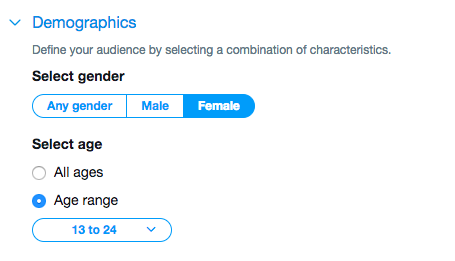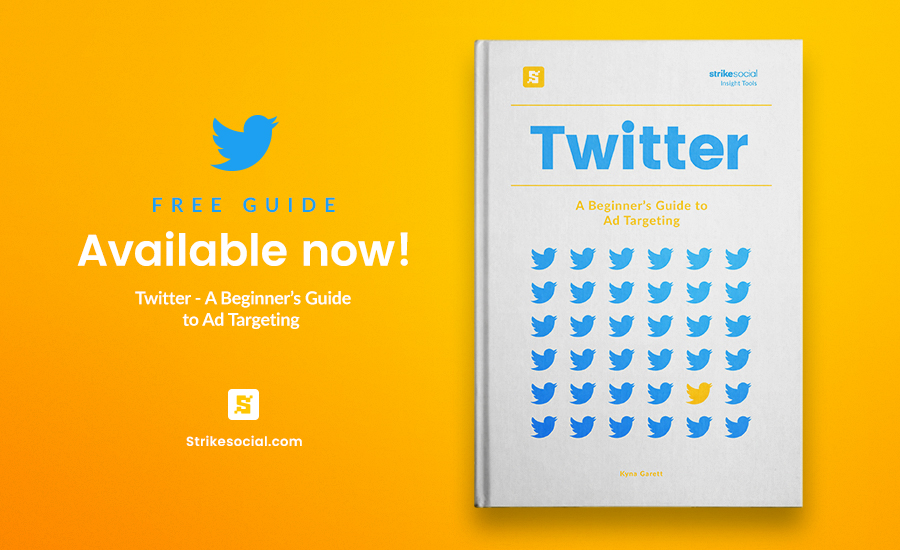While the popular social platform has seen a small increase in active users over the last year, there are still 330 million monthly active users choosing Twitter as their go-to social networking platform for news and updates. If we dive deeper into the 2018 Twitter statistics, we know that 46 percent of all users on Twitter are using the network daily.
Of that 46 percent, users on Twitter are more likely to be young adults living in urban areas. How do brands reach these users though?
Twitter for Business helps brands get in front of the right people through several ad targeting options. Advertisers on the platform should enlist the role of ad targeting to focus on demographic specifics and behavioral patterns among a variety of targeting options available. Fortunately, Twitter offers several advertising opportunities to reach your ideal target audience.
In this blog, we’ll uncover the details behind Twitter ad targeting options available on the platform and how to make the most of them for your campaigns.
RELATED ARTICLEThe advertiser’s guide to Twitter CardsLearn to navigate the world of Twitter Cards and determine which can be used to assist your business goals.READ MORE
Follower targeting
Follower targeting lets you target followers of relevant accounts. These are people who are likely to share similar interests to your business because they already follow brands similar to yours. By choosing to target the followers of similar Twitter accounts, Twitter will automatically create an audience based on the interests of those followers.
This means that you must analyze who your competitors, influencers and similar audiences are. You might also consider targeting followers of industry news accounts.
Best practices
- Utilize search.twitter.com to find industry influencers worth targeting.
- Don’t always target accounts with millions of followers. Target the accounts with the most relevant following to your brand.
- To start, focus on 30 usernames per campaign and make sure your potential reach is at least 50,000 followers.
- Measure ongoing performance through the Twitter Ad Manager and refine your target audience as needed.
Keyword targeting
Twitter is a platform where people are constantly expressing their thoughts, opinions, wants and needs. Twitter ad targeting gives you the option to target based on recently tweeted phrases or recently searched items, getting you in front of people when it matters the most. This method requires a preconceived approach to forming your target audience, but it’s an ideal option for reaching your audience when you are most relevant to them.
Best practices
- Use your knowledge from search.
- Review the analytics from your campaigns after the first week. What is working and what isn’t? Which keywords receive more engagement? Add similar keywords to your high-performing terms.
- Twitter is all about timing. Establish times when your keyword will resonate with your audience the most.
Emoji targeting
In 2016, Twitter began letting brands target people using emojis. Emoji targeting falls within the same category as keyword targeting, but the approach is slightly different. Emoji targeting can be lucrative if used correctly. Brands should understand the context of emojis and how they are being used that might be relevant to their business.
Currently, the only available emojis to target are included on this full Unicode emoji list. The list is also important to help understand emoji context.
Best practices
- Use emojis that make the most sense to your brand. Some emojis can have multiple meanings or difficult to interpret, so it’s best to use emojis you know that make sense to your business.
- Consider demographics when it comes to targeting emojis, as some groups may use them differently or more than others.
Gender & age targeting
While Twitter doesn’t ask its users for their gender, it does read into signals for gender-based ad targeting. It’s not perfect, but for example, if your audience consists of mostly women, Twitter gives you the option to target these gender specifics. Twitter has found their public signals for gender targeting is more than 90 percent accurate.
You have the option to target men, women or any gender, as well as all ages or specify an age range.

Best practices
- Gender and age targeting are not typically used as standalone targets. Combine this method with other targeting options, such as location, interest or device targeting to refine your audience.
- Rather than assuming what is going to work, run separate campaigns for each gender to test campaign performance.
Language targeting
Like gender targeting, Twitter uses a number of signals in conjunction with the user’s language settings in their profile to determine the user’s language. This means you can also target multilingual users, for example, if they have their settings set to English but may also tweet in Spanish.
Best practices
- Utilize this targeting method during global events or holidays.
- Conduct multilingual keyword research.
- Use landing pages that use the same language as your ads.
Location targeting
To get more granular with your targeting, you have the option to target based on country, city or zip code. Location targeting, or geo-targeting, allows you to get more specific with your reach. For example, if you serve multiple locations and only want to appear to users in those areas, this option helps you maintain relevance in those places.
Find the complete list of countries available to target here.
Best practices
- If you choose not to target a location, your Promoted Tweets will be shown globally. Utilize this feature to focus on more relevant users.
- Use landing pages specific to locations you are targeting.
- Take advantage of events that happen at specific locations, for example, where a major sporting event takes place.
Interest targeting
An important Twitter ad targeting option is the use of interests. Brands can target people based on broad or specific interests that run parallel to their business. There are 25 interest categories to choose from that extend into 350 sub-categories.

Twitter allows up to two interests per campaign. If you want to refine a selected audience for a campaign, it’s best to monitor what’s working and what isn’t and adjust your interest selections as needed.
Best practices
- Twitter’s interests are broad, so focus on the variety of sub-interests available to narrow your ad target.
- If you feel more categories meet your campaign, split test the categories to determine optimal performance.
Behavior targeting
This option is only available to U.S. and UK advertisers. It allows you to reach people based on a variety of behaviors, anywhere from a user’s online and offline purchases to annual household income. Other opportunities can include what type of restaurants a user frequents, their buying styles or the type of car they own.
How does this type of targeting pertain to brands? Let’s say, for example, you are a brand selling high-end vehicles. You can target users who have made purchases at high-end dealerships in the past or based on annual household income. You’re trying to reach the most qualified buyers who meet a certain persona.
Best practices
- Narrow what buyer traits to go after based on the style of your brand. The more specific the buyer trait, the more expensive your cost-per-click or cost-per-conversion may be.
- Start with the basic traits first, and test campaign performance.
Device targeting
Device targeting on Twitter gives advertisers multiple targeting abilities:
- Operating system
- Type of device
- Wi-Fi connectivity
- Type of mobile carrier
- New device
Why would these matter? Each one has a specific use. For example, users on new devices are more likely to have interest in new apps or services. Additionally, Android and iOS users might behave differently or have different interests.
Best practices
- Segment your campaigns between different devices and identify what performs better.
- Make sure your website and landing page are responsive to mobile devices.
Tailored and flexible audiences
Twitter allows you to tailor your audiences through web, mobile app or list. These tailored audiences let you target those who have come in contact with your brand in the past. This is also called retargeting.

Let’s break down the different targeting methods:
Web: You can target users who have been to your website or took action on your site. By installing Twitter’s website tag, you can collect this data and target your custom audience via Twitter Cards.
Mobile Apps: Similar to web, if you have a mobile app, you can target users who have taken specific action on your app.
Lists: This option is pretty straightforward. Simply upload a complete or segmented CRM list directly to Twitter to target users who appear on that list. You can also upload an email list or use Twitter usernames.
The option is the first available when setting up your campaign. If you don’t wish to use a single tailored audience, you can combine multiple tailored audiences into a flexible audience.

Best Practices
- Refine your audience by combining tailored audiences with one of the other Twitter ad targeting methods.
- Use lookalike targeting to find new audience opportunities.
Related: The advertiser’s guide to social media ad retargeting
Tying it all together
With the precision of Twitter ad targeting, the possibilities are endless. There are many combinations to test to determine a qualified target audience.
Through segmenting and testing data, you can get more granular with your targeting on Twitter. For example, you might combine a tailored audience with interest and behavioral targeting to define the right audience.
No matter your goal, remember to keep your audience in mind and measure which campaigns are resonating with people.








